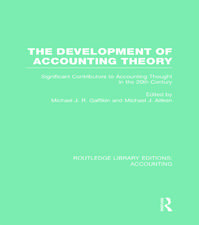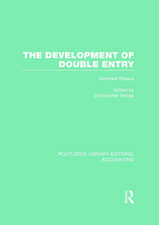Equity Capital: From Ancient Partnerships to Modern Exchange Traded Funds: Routledge International Studies in Business History
Autor Geoffrey Poitrasen Limba Engleză Hardback – 6 mai 2016
The first part of this book examines the rudimentary commercial ventures that characterized trading for profit from ancient times until the contributions of the medieval scholastics that affirmed the moral value of equity capital. The second part deals with the evolution of equity capital organization used in seaborne trade of the medieval and Renaissance Italian city states and in the early colonization ventures of western European powers and ends with the emergence in the market for tradeable equity capital shares during the 17th century. The third part begins with the 1719-1720 Mississippi scheme and South Sea bubbles in northern Europe and continues to cover the transition from joint stock companies to limited liability corporations with autonomous shares in England, America and France during the 19th century. This part ends with a fundamental transition in the social conception of equity capital from a concern with equity capital organization to the problem of determining value. The final part is concerned with the evolving valuation and management of equity capital from the 1920s to the present. This period includes the improvement corporate accounting for publicly traded shares engendered by the Great Depression that has facilitated the use of ‘value investing’ techniques and the conflicting emergence of portfolio management methods of modern Finance.
Equity Capital is aimed at providing material relevant for academic presentations of equity valuation history and methods, and is targeted at researchers, academics, students and professionals alike.
| Toate formatele și edițiile | Preț | Express |
|---|---|---|
| Paperback (1) | 313.47 lei 43-57 zile | |
| Taylor & Francis – 8 iun 2018 | 313.47 lei 43-57 zile | |
| Hardback (1) | 855.50 lei 43-57 zile | |
| Taylor & Francis – 6 mai 2016 | 855.50 lei 43-57 zile |
Din seria Routledge International Studies in Business History
-
 Preț: 348.87 lei
Preț: 348.87 lei -
 Preț: 356.17 lei
Preț: 356.17 lei -
 Preț: 319.05 lei
Preț: 319.05 lei -
 Preț: 325.49 lei
Preț: 325.49 lei -
 Preț: 355.77 lei
Preț: 355.77 lei -
 Preț: 416.22 lei
Preț: 416.22 lei -
 Preț: 489.26 lei
Preț: 489.26 lei - 18%
 Preț: 1109.18 lei
Preț: 1109.18 lei - 18%
 Preț: 1000.27 lei
Preț: 1000.27 lei -
 Preț: 383.63 lei
Preț: 383.63 lei -
 Preț: 415.24 lei
Preț: 415.24 lei - 12%
 Preț: 302.36 lei
Preț: 302.36 lei - 16%
 Preț: 297.99 lei
Preț: 297.99 lei - 18%
 Preț: 1109.18 lei
Preț: 1109.18 lei - 18%
 Preț: 1276.97 lei
Preț: 1276.97 lei - 31%
 Preț: 767.47 lei
Preț: 767.47 lei -
 Preț: 465.49 lei
Preț: 465.49 lei -
 Preț: 489.69 lei
Preț: 489.69 lei - 18%
 Preț: 729.55 lei
Preț: 729.55 lei - 18%
 Preț: 1172.58 lei
Preț: 1172.58 lei -
 Preț: 473.04 lei
Preț: 473.04 lei - 18%
 Preț: 705.53 lei
Preț: 705.53 lei - 15%
 Preț: 459.60 lei
Preț: 459.60 lei - 26%
 Preț: 876.36 lei
Preț: 876.36 lei -
 Preț: 414.32 lei
Preț: 414.32 lei - 18%
 Preț: 1166.68 lei
Preț: 1166.68 lei - 18%
 Preț: 1138.65 lei
Preț: 1138.65 lei - 18%
 Preț: 1065.06 lei
Preț: 1065.06 lei - 15%
 Preț: 699.51 lei
Preț: 699.51 lei - 28%
 Preț: 820.32 lei
Preț: 820.32 lei -
 Preț: 468.36 lei
Preț: 468.36 lei - 18%
 Preț: 1001.07 lei
Preț: 1001.07 lei - 25%
 Preț: 767.88 lei
Preț: 767.88 lei - 12%
 Preț: 313.47 lei
Preț: 313.47 lei - 18%
 Preț: 1282.82 lei
Preț: 1282.82 lei - 18%
 Preț: 1056.28 lei
Preț: 1056.28 lei - 15%
 Preț: 458.62 lei
Preț: 458.62 lei - 18%
 Preț: 1118.46 lei
Preț: 1118.46 lei
Preț: 855.50 lei
Preț vechi: 1220.38 lei
-30% Nou
Puncte Express: 1283
Preț estimativ în valută:
163.75€ • 177.93$ • 137.64£
163.75€ • 177.93$ • 137.64£
Carte tipărită la comandă
Livrare economică 21 aprilie-05 mai
Preluare comenzi: 021 569.72.76
Specificații
ISBN-13: 9781138819931
ISBN-10: 113881993X
Pagini: 566
Ilustrații: 27 black & white illustrations, 35 black & white tables, 13 black & white line drawings
Dimensiuni: 152 x 229 x 37 mm
Greutate: 0.89 kg
Ediția:1
Editura: Taylor & Francis
Colecția Routledge
Seria Routledge International Studies in Business History
Locul publicării:Oxford, United Kingdom
ISBN-10: 113881993X
Pagini: 566
Ilustrații: 27 black & white illustrations, 35 black & white tables, 13 black & white line drawings
Dimensiuni: 152 x 229 x 37 mm
Greutate: 0.89 kg
Ediția:1
Editura: Taylor & Francis
Colecția Routledge
Seria Routledge International Studies in Business History
Locul publicării:Oxford, United Kingdom
Public țintă
Postgraduate and UndergraduateCuprins
Part 1: Equity Capital Prior to Joint Stock Companies 1.1 Etymology and Concepts of Law 1.2 Equity Shares in Antiquity 1.3 Societas, Usury and Risk Part 2: From Commenda to Joint Stock Company 2.1 Evolution of Accounting and Commercial Arithmetic 2.2 Characteristics of Early Joint Stocks Companies 2.3 Early Markets for Trading in Shares Part 3: The Rising of Limited Liability Corporations 3.1 Mania, Manipulation and Joint Stock Valuation 3.2 Joint Stock, Limited Liability and Incorporation 3.3 Stocks, Shares and the Science of Investments Part 4: Conceiving Modern Equity Capital 4.1 Equity Security Regulation and the Crash of 1929 4.2 The Separation of Ownership and Control
Notă biografică
Geoffrey Poitras is a Professor of Finance at Simon Fraser University, Canada.
Recenzii
"Financial crises and stock market crashes are all over financial history. These episodes have already been described in great detail and yet they keep surprising us. This book deals with the underlying problem: the inherent difficulty of equity valuation. From ancient times until the crash of 1929 he describes the development of approaches to valuing equity securities. I am glad to recommend this book to anybody who wants to better understand financial markets." –Abe de Jong, Erasmus University, the Netherlands
"Poitras provides what is by far the most comprehensive and best documented contribution to on the topic of the historical foundations of modern equity valuation." –Stephen Buser, Professor Emeritus, Ohio State University, USA
"Poitras provides what is by far the most comprehensive and best documented contribution to on the topic of the historical foundations of modern equity valuation." –Stephen Buser, Professor Emeritus, Ohio State University, USA
Descriere
Despite a widespread general interest in the topic, there are relatively few historical treatments of equity security valuation available that conform to academic standards. Equity Capital looks to address this imbalance in the literature by presenting historical approaches to the valuation of equity securities, from ancient times, to the emergence of tradeable equity claims in the 1600s, to Securities Act and Securities and Exchange Act in the 1930s, and into the modern era. This book provides material relevant for academic presentations of equity valuation history and methods, and is targeted at researchers, academics, students and professionals alike.















